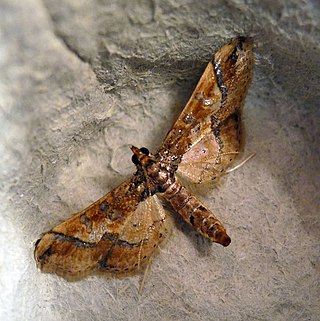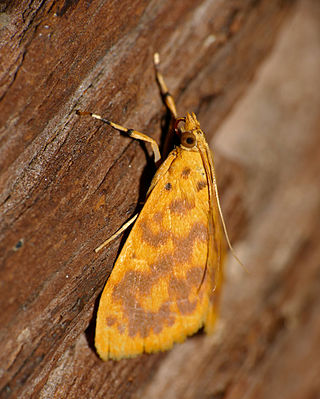
Spilomelinae is a very species-rich subfamily of the lepidopteran family Crambidae, the crambid snout moths. With 4,135 described species in 344 genera worldwide, it is the most speciose group among pyraloids.
Asturodes is a genus of snout moths in the subfamily Spilomelinae of the family Crambidae. The genus is placed in the tribe Margaroniini.

Conchylodes is a genus of snout moths in the family Crambidae. The genus comprises 21 species and is placed in the tribe Udeini.
Hydropionea is a genus of moths of the family Crambidae. The 13 described species are distributed in Central and South America.

Nagiella is a genus of moths of the family Crambidae. It was established by Eugene G. Munroe in 1964 as a replacement name for NagiaWalker, 1866, a name that was preoccupied by NagiaWalker, 1858 in the Lepidoptera family Erebidae.
Plantegumia is a genus of moths of the family Crambidae. The three described species are distributed in Central and South America.
Sisyracera is a genus of snout moths in the subfamily Spilomelinae of the family Crambidae. It was described in 1890 by Heinrich Benno Möschler with Leucinodes preciosalis as type species, now considered a synonym of Sisyracera subulalis. The genus has been placed in the tribe Udeini.

Hydririni is a tribe of the species-rich subfamily Spilomelinae in the pyraloid moth family Crambidae.

Lineodini is a tribe of the species-rich subfamily Spilomelinae in the snout moth family Crambidae.
Udeini is a tribe in the species-rich subfamily Spilomelinae in the pyraloid moth family Crambidae. The tribe was erected by Richard Mally, James E. Hayden, Christoph Neinhuis, Bjarte H. Jordal and Matthias Nuss in 2019.
Wurthiini is a tribe of the species-rich subfamily Spilomelinae in the pyraloid moth family Crambidae.

Herpetogrammatini is a tribe of the species-rich subfamily Spilomelinae in the pyraloid moth family Crambidae. The tribe was erected by Richard Mally, James E. Hayden, Christoph Neinhuis, Bjarte H. Jordal and Matthias Nuss in 2019.
Asciodini is a tribe of the species-rich subfamily Spilomelinae in the pyraloid moth family Crambidae. The tribe was erected by Richard Mally, James E. Hayden, Christoph Neinhuis, Bjarte H. Jordal and Matthias Nuss in 2019.

Steniini is a tribe of the species-rich subfamily Spilomelinae in the pyraloid moth family Crambidae. The tribe was erected by Achille Guenée in 1854.
Malickyella is a genus of snout moth in the species-rich subfamily Spilomelinae of the family Crambidae. The genus was described in 2010 by the German entomologists Wolfram Mey and Wolfgang Speidel based on material from South-East Asia. The four species of the genus are distributed in the lowland forests of the Indomalayan realm, stretching from the Indian state of Assam to the Philippines.
Prophantis coenostolalis is a moth in the family Crambidae. It was described by George Hampson in 1899. It is found in Sierra Leone. It was formerly placed in the Pyraustinae genus Thliptoceras.
Prophantis xanthomeralis is a moth in the family Crambidae. It was described by George Hampson in 1918. It is found in Malawi. It was formerly placed in the Pyraustinae genus Thliptoceras.
Conchylodes graphialis is a species of snout moth in the tribe Udeini of the subfamily Spilomelinae. It was described by William Schaus in 1912 based on material collected in Costa Rica.
Cheverella is a monotypic genus of snout moths in the subfamily Spilomelinae of the family Crambidae. It contains only one species, Cheverella galapagensis, which is endemic to the Galápagos Islands of Ecuador. Both the genus and the species were first described by Bernard Landry in 2011. The genus is placed in the tribe Udeini.

Portentomorphini is a tribe of the subfamily Pyraustinae in the pyraloid moth family Crambidae. The tribe was initially erected by Hans Georg Amsel in 1956.








